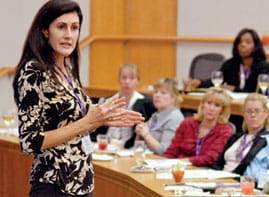A healthy change
Professor Linda Emanuel seeks to improve risk management in the medical industry through the Patient Safety Education Project
By Rachel Farrell8/12/2009 - In 1999, a 37-year-old woman checked herself into a well-respected hospital in New England for ankle replacement surgery.
It was supposed to be a simple procedure — one of many operations the woman needed to treat her club foot, a condition she had had since birth. But shortly after the patient received a dose of anesthesia, she went into cardiac arrest. As she clung to life, doctors rushed to perform emergency open chest cardiac resuscitation.
The woman survived. But while she lay in the recovery room, confused by what had happened, doctors told her they couldn’t explain why her heart had stopped. They likely had good reason to keep quiet: If the patient learned the truth, she could sue the hospital.
That’s because the hospital’s anesthesiologist had accidentally injected local anesthetic into her blood vessel instead of into the local tissues. The anesthetic traveled to her heart and caused cardiac arrest.
It’s situations like this that have fueled the need for the Patient Safety Education Project, says Linda Emanuel, a professor of Health Industry Management at the Kellogg School and a professor of medicine at Northwestern University. Launched in May 2008, the project aims to educate and train healthcare professionals in methods that can improve patient safety and prevent adverse medical events.
Housed in Northwestern University’s Buehler Center on Aging, the goal of the project is to recruit healthcare professionals — such as doctors, nurses and quality improvement officers — and train them in techniques for analyzing patient safety problems, determining methods of prevention, and educating others on quality improvement strategies. The project hopes to create a “ripple effect,” Emanuel says, in which methods to improve patient safety become widely adopted among healthcare organizations.
For example, to teach healthcare professionals about preventing hospital-acquired infections, the trainers might ask the trainees to reenact a case study. In this instance, one healthcare professional would act as the infectious disease doctor, while another would act as the maintenance manager and another might act as the quality improvement officer. Working in teams, the trainees would identify various barriers and solutions to arriving at the desired result: no hospital-acquired infections.
Interestingly, the project’s curriculum is based on quality improvement strategies that are frequently used in the corporate world.
“It uses a systems engineering and management-oriented approach to quality improvement that has had good effect in the private sector,” says Emanuel. “[For example], every time something goes wrong at Toyota, the company does an analysis and tries to figure out how to prevent it from happening again.”
Recognizing that adverse medical events are risk management issues, the Zell Center for Risk Management has provided generous funding for the project. Emanuel agrees that the partnership makes sense.
“Financially, everything goes awry when a medical disaster happens,” she says, pointing to the potential legal ramifications and insurance costs. “What we need is open information so [hospitals] can learn from their mistakes and make open-hearted apologies to patients and their families that have suffered. We need to learn together and work together as opposed to suing [each other] for damages.”
At the inaugural event in May 2008, the Patient Safety Education Project trained 45 professionals from the healthcare sector. Its next major session, entitled “Become a PSEP Safety Trainer Conference,” is scheduled to take place Jan. 11-15 in Winston-Salem, North Carolina and is expected to draw 100 professionals. Emanuel hopes those numbers will continue to multiply.
“I’d like to see the project continue to disseminate practice improvement projects to allow the medical industry to reap all of the benefits of quality improvement that the business community has been refining for 70 to 80 years,” she says. “We want to help the medical industry catch up.”






